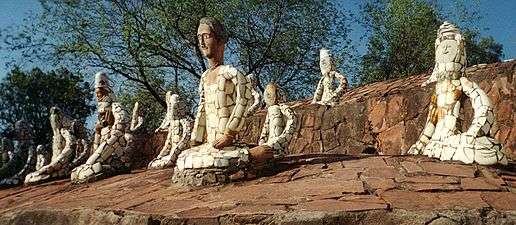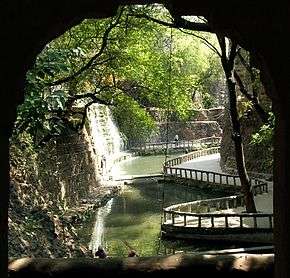Rock Garden of Chandigarh


The Rock Garden of Chandigarh is a sculpture garden in Chandigarh, India. It is also known as Nek Chand's Rock Garden after its founder Nek Chand, a government official who started the garden secretly in his spare time in 1957. Today it is spread over an area of 40 acres (161874.25 m²). It is completely built of industrial and home waste and thrown-away items.[1][2]
It is near Sukhna Lake.[3] It consists of man-made interlinked waterfalls and many other sculptures that have been made of scrap and other kinds of wastes (bottles, glasses, bangles, tiles, ceramic pots, sinks, electrical waste,brokenpipes, etc.) which are placed in walled paths.[4]
In his spare time, Nek Chand started collecting materials from demolition sites around the city. He recycled these materials into his own vision of the divine kingdom of Sukrani, choosing a gorge in a forest near Sukhna Lake for his work. The gorge had been designated as a land conservancy, a forest buffer established in 1902 that nothing could be built on. Chand’s work was illegal, but he was able to hide it for 18 years before it was discovered by the authorities in 1975. By this time, it had grown into a 12-acre (49,000 m2) complex of interlinked courtyards, each filled with hundreds of pottery-covered concrete sculptures of dancers, musicians, and animals.[5]
His work was in danger of being demolished, but he was able to get public opinion on his side. In 1976 the park was inaugurated as a public space. Nek Chand was given a salary, a title ("Sub-Divisional Engineer, Rock Garden"), and 50 laborers so that he could concentrate full-time on his work. It appeared on an Indian stamp in 1983.[6] The Rock Garden is still made out of recycled materials. With the government’s help, Chand was able to set up collection centers around the city for waste, especially rags and broken ceramics.[7][8]
When Chand left the country on a lecture tour in 1996, the city withdrew its funding, and vandals attacked the park. The Rock Garden Society took over the administration and upkeep of this unique visionary environment.[9][10]
The garden is visited by over 5,000 people daily, with more than 12 million visitors since its inception.[11]
Teej Festival is a festival celebrated with lot of pride by women at Rock Garden Chandigarh.
Gallery
 Entrance
Entrance Dedication day memorial, 7 July 1988.
Dedication day memorial, 7 July 1988. Rock Garden,Chandigarh,India
Rock Garden,Chandigarh,India Dancing girls at Rock Garden, Chandigarh.
Dancing girls at Rock Garden, Chandigarh. Decorated wall at Rock Garden.
Decorated wall at Rock Garden.
Further reading
- Nek Chand's outsider art: the rock garden of Chandigarh, by Lucienne Peiry, John Maizels, Philippe Lespinasse, Nek Chand. Published by Flammarion, 2006. ISBN 2-08-030518-2.
- The Collection, the Ruin and the Theatre: Architecture, sculpture and landscape in Nek Chand's Rock Garden, by Soumyen Bandyopadhyay and Iain Jackson. Liverpool University Press, 2007. ISBN 1-84631-120-9.
- Sublime Spaces and Visionary Worlds: Built Environments of Vernacular Artists, by Leslie Umberger (author), Erika Doss (contributor), Ruth Kohler (contributor), Lisa Stone (contributor).
References
- ↑ Nek Chand Rock Garden Sublime Spaces and Visionary Worlds: Built Environments of Vernacular Artists, by Leslie Umberger, Erika Lee Doss, Ruth DeYoung Kohler, Lisa Stone. Published by Princeton Architectural Press, 2007. ISBN 1-56898-728-5. Page 319-Page 322.
- ↑ "Night tourism to light up 'rocks'". The Times of India. 2012-07-01. Retrieved 2012-10-30.
- ↑ "Working wealth out of waste".
- ↑ "Chandigarh, the City Beautiful: Environmental Profile of a Modern Indian City".
- ↑ "Picturing South Asian Culture in English: Textual and Visual Representations".
- ↑ "Pak scribes tour city, visit Rock Garden". The Indian Express. 22 November 2011. Retrieved 12 February 2017.
- ↑ TNN (1 October 2009). "'Pricey' weddings at Rock Garden". The Times of India. Retrieved 12 February 2017.
- ↑ "Chandigarh Rock Garden to get a face-lift".
- ↑ "Encyclopaedia of Tourism Resources in India, Volume 1".
- ↑ "The Rock Garden, Chandigarh, India," PBS Independent Lens, Off the Map
- ↑ "Discover India by Rail".
External links
| Wikimedia Commons has media related to Rock Garden, Chandigarh. |